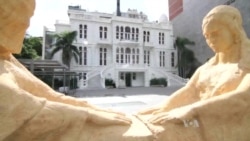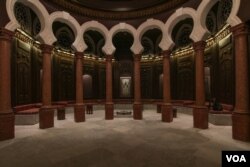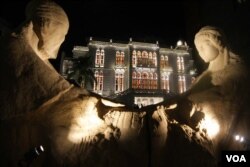Following eight years and nearly $14 million in renovations, Lebanon's iconic Sursock Museum reopened its doors to the public earlier this month in Beirut.
In doing so, it has given another boost to a resurgent cultural scene that is flourishing despite the instability of the country that spawned it.
Originally the home of aristocrat Nicolas Ibrahim Sursock — bequeathed to the city upon his death — the museum opened in 1961 and quickly became a place where visiting dignitaries and leading creative artists mingled.
It endured the country’s civil war, which ended in 1990, but major work was needed.
The result is a hugely increased capacity for Middle Eastern art, sculpture and photography stretching back to the mid-19th century.
Most of the expansion was done beneath the mansion, where the addition of a subterranean library and exhibition space are among the reasons it is now effectively five times larger.
Museum director Zeina Arida is keen to assert that the untouched and grand exterior — which draws upon Ottoman and Venetian architecture — belies a more inclusive approach.
“The main idea is that this is a public space, and a museum that everyone should feel welcome in,” she explained, adding that a main measure of success would be in “attracting different groups and social classes.”
This effort at inclusiveness extends to drawing upon the museum’s long-standing reputation for showcasing new art through its annual Salon D’Automne exhibition.
“Having an art museum in a city such as Beirut has enabled the creation of a much more vibrant artist life,” she said. “It gave opportunities to young artists to get exposure.”
Art scene
Opportunities for such exposure to culture seem to be increasing by the day in the city.
Competition began at the start of the month to design a new modern art museum, which is planned for completion by 2020.
Earlier this month, a $100 million gallery on the outskirts of Beirut showcasing the high-value, global art collection of Lebanese businessman Tony Salamé drew international attention.
Hard work done over the 1990s, which saw the creation of a number of institutions encouraging art in the country, has led to a “moment of profound expansion” culturally, and all largely without the help of a state too caught up in other issues, claimed art history expert Rico Franses.
“The country is in crisis,” said Franses, a professor at the American University of Beirut. “There’s all kinds of problems — refugees, governmental, political,” he explained, referring in part to the impact of the war in neighboring Syria.
“But you have to say, given all those crises, Lebanese society is extraordinary, the degree to which it supports this really flourishing art scene.“
A bigger window
Yet, though Lebanese figures like Walid Raad, who is currently exhibiting at New York’s renowned Museum of Modern Art, have made it onto the international stage, others argue that there is still far more to be done.
Jouama Asseily returned to Lebanon in 2006 after studying art in France and the United States, and went on to join Ashkal Alwan, an association set up in 1994 to promote creativity.
She launched her first gallery — named Marfa’ — this month.
“All eyes are on the region right now. People are curious — they know we have great artists showing outside the country, and want to know more," she told VOA, saying that despite the country’s growing reputation, artists still have difficulty getting exposure.
“They want to discover more Lebanese artists, and they need a bigger window to do that.”
And "it's about time," said Vartan Avakian, the Beirut-based artist whose work is launching Marfa’.
According to Avakian, though relatively rare in Lebanon, the private-public model of the Sursock Museum — where he is also being exhibited — is one that should be emulated.
"Two or three museums is not a lot for a city like Beirut, and it’s about completing a circle — an art institution, a fund, an art space — these all need each other.”
Future hope
The woman leading the Sursock Museum’s rebirth is equally adamant that more must be done.
“We need to continue building our cultural infrastructure,” Arida told VOA.
“We all foresee that the cultural landscape is going to change tremendously in the next five years.”
In the meantime, the mansion’s walls will see works by long-established artists jostling for position alongside up-and-comers like Avakian.
And in doing that, it will offer a sense of continuity between past glory and future hope at a time of wider uncertainty.
“This is a long-term project,” Arida added, smiling, “and anything is possible.”












